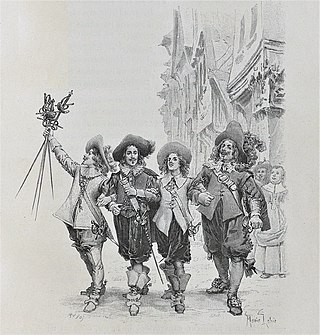
The Three Musketeers is a French historical adventure novel written in 1844 by French author Alexandre Dumas. It is the first of the author's three d'Artagnan Romances. As with some of his other works, he wrote it in collaboration with ghostwriter Auguste Maquet. It is in the swashbuckler genre, which has heroic, chivalrous swordsmen who fight for justice.

Porthos, Baron du Vallon de Bracieux de Pierrefonds is a fictional character in the novels The Three Musketeers (1844), Twenty Years After (1845), and The Vicomte de Bragelonne (1847–1850) by Alexandre Dumas, père. He and the other two musketeers, Athos and Aramis, are friends of the novel's protagonist, d'Artagnan. Porthos is a highly fictionalized version of the historical musketeer Isaac de Porthau.

Athos, Count de la Fère, is a fictional character in the novels The Three Musketeers (1844), Twenty Years After (1845) and The Vicomte de Bragelonne (1847–1850) by Alexandre Dumas, père. He is a highly fictionalised version of the historical musketeer Armand d'Athos (1615–1643).
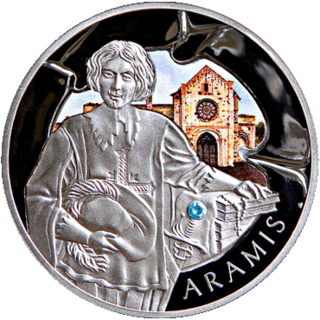
René d'Herblay, alias Aramis, is a fictional character in the novels The Three Musketeers (1844), Twenty Years After (1845), and The Vicomte de Bragelonne (1847–1850) by Alexandre Dumas, père. He and the other two musketeers, Athos and Porthos, are friends of the novels' protagonist, d'Artagnan.

Charles de Batz de Castelmore, also known as d'Artagnan and later Count d'Artagnan, was a French Musketeer who served Louis XIV as captain of the Musketeers of the Guard. He died at the siege of Maastricht in the Franco-Dutch War. A fictionalised account of his life by Gatien de Courtilz de Sandras formed the basis for the d'Artagnan Romances of Alexandre Dumas père, most famously including The Three Musketeers (1844). The heavily fictionalised version of d'Artagnan featured in Dumas' works and their subsequent screen adaptations is now far more widely known than the real historical figure.

The Vicomte of Bragelonne: Ten Years Later is a novel by Alexandre Dumas. It is the third and last of The d'Artagnan Romances, following The Three Musketeers and Twenty Years After. It appeared first in serial form between 1847 and 1850.

Twenty Years After is a novel by Alexandre Dumas, first serialized from January to August 1845. A book of The d'Artagnan Romances, it is a sequel to The Three Musketeers (1844) and precedes the 1847–1850 novel The Vicomte de Bragelonne.

The Three Musketeers is a 1993 action-adventure comedy film from Walt Disney Pictures, Caravan Pictures, and The Kerner Entertainment Company, directed by Stephen Herek from a screenplay by David Loughery. It stars Charlie Sheen, Kiefer Sutherland, Chris O'Donnell, Oliver Platt, Tim Curry and Rebecca De Mornay.
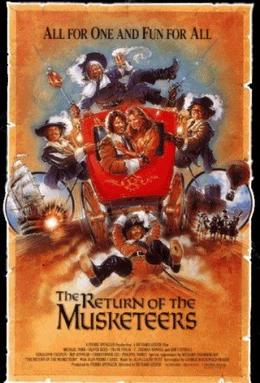
The Return of the Musketeers is a 1989 film adaptation loosely based on the novel Twenty Years After (1845) by Alexandre Dumas. It is the third Musketeers film directed by Richard Lester, following 1973's The Three Musketeers and 1974's The Four Musketeers. Like the other two films, the screenplay was written by George MacDonald Fraser.

The Man in the Iron Mask is a 1939 American historical adventure film very loosely adapted from the last section of the 1847–1850 novel The Vicomte de Bragelonne by Alexandre Dumas, père, which is itself based on the French legend of the Man in the Iron Mask.
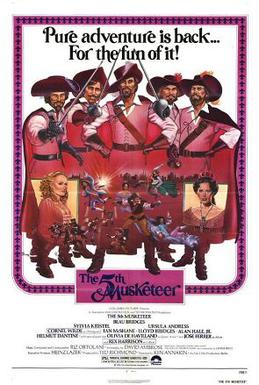
The Fifth Musketeer is a 1979 German-Austrian film adaptation of the last section of the 1847–1850 novel The Vicomte of Bragelonne: Ten Years Later by Alexandre Dumas, père, which is itself based on the French legend of the Man in the Iron Mask. It was released in Europe with the alternative title Behind the Iron Mask.
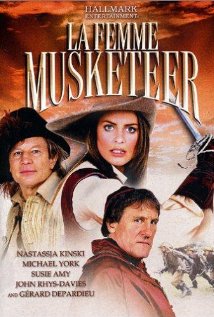
La Femme Musketeer is a made for television movie produced by Hallmark Entertainment and Larry Levinson Productions, filmed on Draguć in Croatia. It originally premiered on June 20, 2004 on Hallmark Channel.

The Three Musketeers is a 1986 Australian made-for-television animated adventure film from Burbank Films Australia. It is based on Alexandre Dumas's classic 1844 French novel, The Three Musketeers, and was adapted by Keith Dewhurst. It was produced by Tim Brooke-Hunt and featured original music by Sharon Calcraft.
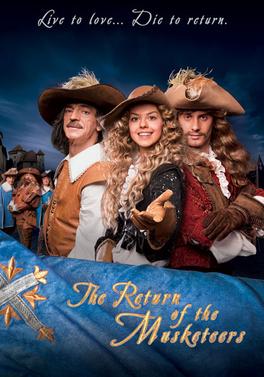
The Return of the Musketeers, or The Treasures of Cardinal Mazarin is a 2009 Russian musical comedy film directed by Georgi Yungvald-Khilkevich.
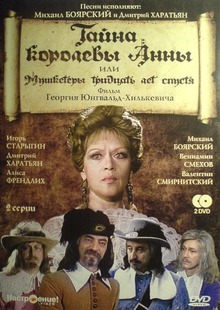
The Secret of Queen Anne or Musketeers Thirty Years After is a 1993 Russian swashbuckler film directed by Georgi Yungvald-Khilkevich based on Alexandre Dumas' 1847-1850 novel The Vicomte de Bragelonne.

At Sword's Point, also known as Sons of the Three Musketeers, is a 1952 American historical action adventure film directed by Lewis Allen and starring Cornel Wilde and Maureen O'Hara. It was shot in Technicolor by RKO Radio Pictures. The film was completed in 1949 but was not released until 1952.

The Three Musketeers is a 1935 film directed by Rowland V. Lee and starring Walter Abel, Heather Angel, Ian Keith, Margot Grahame, and Paul Lukas. It is the first English-language talking picture version of Alexandre Dumas's 1844 novel The Three Musketeers.

Revenge of the Musketeers is a 1994 French swashbuckler adventure film directed by Bertrand Tavernier and starring Sophie Marceau, Philippe Noiret, Claude Rich, and Sami Frey. Set in the seventeenth century, the film is about the daughter of the renowned swordsman D'Artagnan who keeps the spirit of the Musketeers alive by bringing together the aging members of the legendary band to oppose a plot to overthrow the King and seize power. Revenge of the Musketeers was filmed on location at the Château de Biron in Biron, Dordogne and the Château de Maisons in Maisons-Laffitte in France and in Portugal with a budget of $9.1 million.
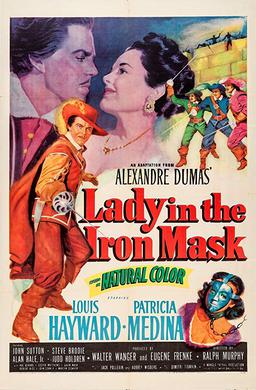
Lady in the Iron Mask is a 1952 American adventure film directed by Ralph Murphy, produced by Walter Wanger and starring Louis Hayward as D'Artagnan and Patricia Medina in the title role. Alan Hale, Jr. portrays Porthos, Judd Holdren plays Aramis, and Steve Brodie appears as Athos in this Three Musketeers adventure film, a reworking of Douglas Fairbanks' 1929 screen epic The Iron Mask, an adaptation of the last section of the 1847-1850 novel The Vicomte de Bragelonne by Alexandre Dumas, père, which is itself based on the French legend of the Man in the Iron Mask. The film's sets were designed by the art director Martin Obzina and shot in Supercinecolor.
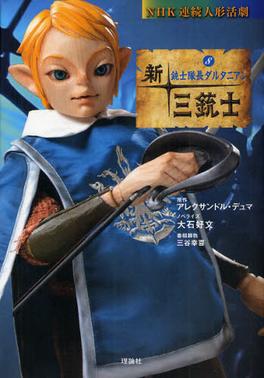
The Three Musketeers is a Japanese puppet television show produced by NHK and broadcast by NHK Educational TV from 12 October 2009 to 28 May 2010. The show is written by Kōki Mitani and the puppets are designed by Bunta Inoue.




















